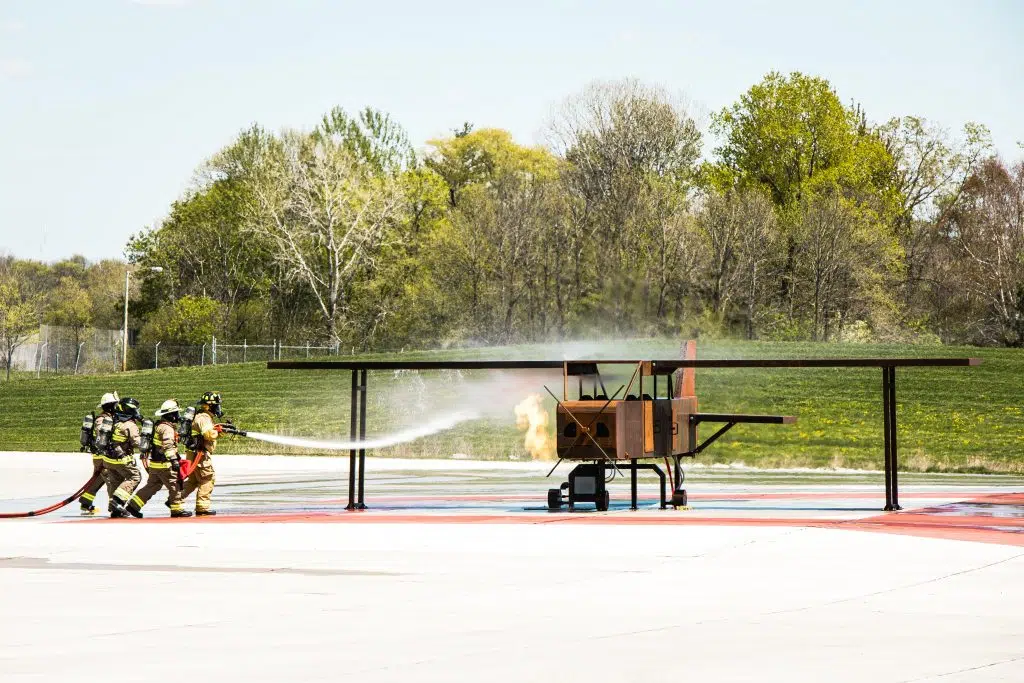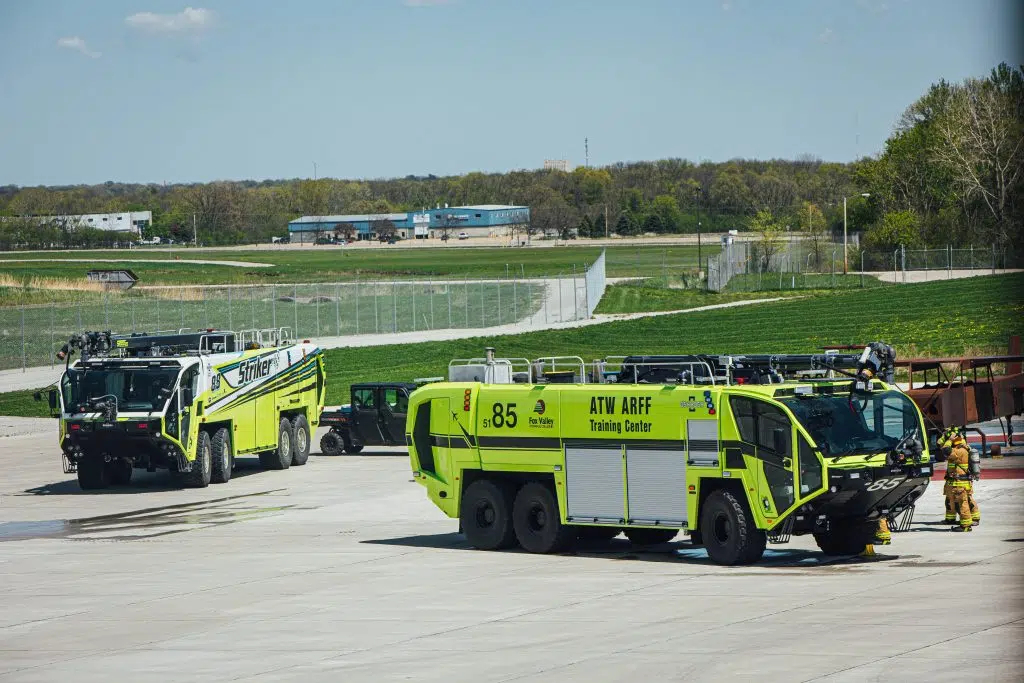APPLETON, WI (WTAQ) – Fox Valley Technical College welcomed its first Airport Rescue and Fire Fighting (ARFF) trainees last summer, and they’re back underway with a new season of the unique training process.
Airport firefighters from across the country and the world are coming to Appleton to learn how to combat emergencies on airport grounds. The facility is the only one of its kind in the Midwest, featuring hands-on training on a prop Boeing 777 and smaller plane modeled after a Cessna.

Trainees practice extinguishing a small plane fire at Fox Valley Technical College’s Airport Rescue and Fire Fighting (ARFF) facility. (WTAQ/Casey Nelson)
“Some of these men and women who come through are very young, very fresh. Some of them have a background in structure [fires], and we’re taking the skills and applying them to the airport firefighting,” said Program Instructor Ben Sokol. “For them to show up and be almost kind of like wide-eyed, like ‘I have no idea what to expect,’ and to leave with the confidence that they know if there’s an incident that they’re going to be able to adequately respond and protect life, it’s a pretty good feeling to make sure that I pass that on to the next group.”
While Wednesday’s trainees were mostly from Wisconsin and Illinois, they’ve had people come from Oregon, Idaho, Indiana, and even overseas.
“The school does a great job. We do some classroom work, we come back out and do practical application and drive the trucks with an instructor to help show us, and then we build from there. So definitely a crawl, walk, run type of method,” said Beau Tibbitts, a trainee from La Crosse. “This type of training, this facility is just remarkable. As live as you can get in a very controlled environment.”
When it comes to fighting fires on an airfield, the approach is a bit different than a typical house fire. Sokol explains that goals and objectives on the exterior approach are completely different, as are the tactics. But once they breach into the aircraft for a rescue or to put out a fire, the tactics become very similar to those utilized in municipal firefighting.
“When you’re dealing with an aircraft fire, you’re looking at tens of thousands of gallons of fuel, hydraulic fluid, liquid oxygen, biofuels, bio-hazardous waste, and it fell out of the sky,” Sokol said. “So bad things can definitely happen. Luckily, they don’t happen very often, but that’s why we do this training. So when it does happen, we can be the best prepared we can to make sure everyone gets off that aircraft safely.”
Another thing people might notice, the trucks. The third iteration of the Oshkosh Strikers.
“There’s no fire hydrants at an airport, so these vehicles are much larger,” business unit director for Oshkosh Airport Products Jack Bermingham said. “They carry a variety of different agents, and a lot of firefighting agents to bring to the potential aircraft scene.”

Oshkosh Striker vehicles utilized to respond to fires on airport grounds. (WTAQ/Casey Nelson)
The company has a partnership with the airport and college to utilize the facility as well.
“We’re able to actually bring even our customers here and and show off this facility and use it in the same context. We’re able to bring more people to the community, flights the airport,” Bermingham explained. “Later this month, we’re bringing a group of probably 30 people from overseas to come in and Fox Valley Technical College is actually going to take them through operator training in our vehicle using the facilities here.”
The entire facility, while operated and utilized mostly by Fox Valley Technical College, is technically on the southern end of Appleton International Airport property.
“For us here locally, we have the opportunity to host fireman visits from all over the world. So they’re staying at hotels, eating in our restaurants, buying our Wisconsin merch, we just think it’s a win, win, win for the entire community,” said ATW Marketing Manager Patrick Tracey. “It’s exciting to see the facility started to get more use and the airport rescue firefighters to get the training that they need and deserve.”
After a similar facility closed in Duluth, Minnesota – Tracey says they saw the opportunity to add the facility at a relatively low cost, and that was appealing to the Federal Aviation Administration.
“They funded the entire project. We received $12 million in funding from the FAA and the state Bureau of Aeronautics, which made this possible,” Tracey said.
A video recapping Wednesday’s training can be seen here:




Comments